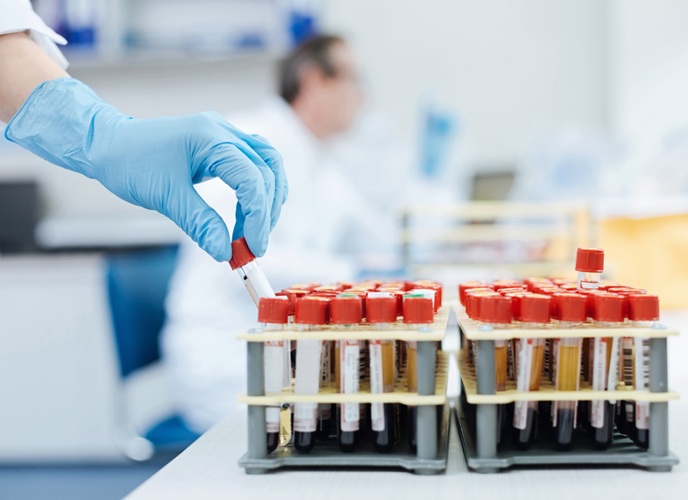Expo
Medica
view channel
view channel
view channel
view channel
view channel
view channel
view channel
view channel
view channel
Clinical Chem.Molecular DiagnosticsHematologyImmunologyMicrobiology
TechnologyIndustry
Events

- New Saliva Test Rapidly Identifies Paracetamol Overdose
- POC Saliva Testing Device Predicts Heart Failure in 15 Minutes
- Screening Tool Detects Multiple Health Conditions from Single Blood Drop
- Integrated Chemistry and Immunoassay Analyzer with Extensive Assay Menu Offers Flexibility, Scalability and Data Commutability
- Rapid Drug Test to Improve Treatment for Patients Presenting to Hospital
- Groundbreaking Test Could Detect Prostate Cancer Within Minutes Via Urine Sample
- Groundbreaking Blood Test Detects Earliest Signs of Pancreatic Cancer Before Symptoms Appear
- Study Offers New Insights into Alzheimer's Disease Biomarkers
- Blood Test for Early Alzheimer’s Detection Could Help Slow Disease Progression
- Cost-Effective Blood Test Could Detect Early Brain Changes Leading to Dementia
- Personalized CBC Testing Could Help Diagnose Early-Stage Diseases in Healthy Individuals
- Non-Invasive Test Solution Determines Fetal RhD Status from Maternal Plasma
- First-Of-Its-Kind Smartphone Technology Noninvasively Measures Blood Hemoglobin Levels at POC
- Next Gen CBC and Sepsis Diagnostic System Targets Faster, Earlier, Easier Results
- Newly Discovered Blood Group System to Help Identify and Treat Rare Patients
- Simple Blood Test Could Detect Drug Resistance in Ovarian Cancer Patients
- Advanced Imaging Method Maps Immune Cell Connections to Predict Cancer Patients Survival
- Computational Tool Predicts Immunotherapy Outcomes for Metastatic Breast Cancer Patients
- Biomarker Could Predict Immunotherapy Response in Liver Cancer
- Epigenetic Test Could Determine Efficacy of New Immunotherapy Treatments Against Multiple Myeloma
- Syndromic PCR Test Rapidly and Accurately Identifies Pathogens in Patients with Tropical Fever Infections
- 1 Hour Direct-From-Blood Test Detects 95% Of Pathogens Associated with Bloodstream Infections
- New Hands-Free Rapid Test Detects Bacteria in Fluids
- Unique Blood Biomarker Shown to Effectively Monitor Sepsis Treatment
- High-Accuracy Bedside Test to Diagnose Periprosthetic Joint Infection in Five Minutes
- FET-Based Sensors Pave Way for Portable Diagnostic Devices Capable of Detecting Multiple Diseases
- Paper-Based Biosensor System to Detect Glucose Using Sweat Could Revolutionize Diabetes Management
- First AI-Powered Blood Test Identifies Patients in Earliest Stage of Breast Cancer
- Optical Biosensor Rapidly Detects Monkeypox Virus at Point of Care
- Nanomaterial-Based Diagnostic Technology Accurately Monitors Drug Therapy in Epilepsy Patients
- Worldwide Initiative Aims to Develop Globally Generalizable Blood-Based Tests for Alzheimer’s Disease
- Hologic Enters into Agreement with CDC for H5N1 Bird Flu Test Development
- Quanterix Acquires Magnetic Bead Tech Firm Emission
- LGC Acquires German Quality Controls Maker DiaMex
- Bio-Techne and ALZpath Partner to Advance Neurodegenerative Disease Research and Treatment
- Gene Panel Predicts Disease Progession for Patients with B-cell Lymphoma
- New Method Simplifies Preparation of Tumor Genomic DNA Libraries
- New Tool Developed for Diagnosis of Chronic HBV Infection
- Panel of Genetic Loci Accurately Predicts Risk of Developing Gout
- Disrupted TGFB Signaling Linked to Increased Cancer-Related Bacteria
- New Microscopy Technique Enables Rapid Tumor Analysis by Surgeons in OR
- AI Model Excels at Analyzing Diverse Cancer Types and Unseen IHC Data
- AI Tool Analyzes Placentas at Birth to Accurately Detect Health Risks
- Optimized Pooled Testing Approach Could Transform Public Health Screening for Infectious Diseases
- Breakthrough Method to Enable Early Risk Stratification of Deadly Blood Cancer

Expo
 Medica
view channel
view channel
view channel
view channel
view channel
view channel
view channel
view channel
view channel
view channel
view channel
view channel
view channel
view channel
Clinical Chem.Molecular DiagnosticsHematologyImmunologyMicrobiology
TechnologyIndustry
Events
Advertise with Us
Medica
view channel
view channel
view channel
view channel
view channel
view channel
view channel
view channel
view channel
view channel
view channel
view channel
view channel
view channel
Clinical Chem.Molecular DiagnosticsHematologyImmunologyMicrobiology
TechnologyIndustry
Events
Advertise with Us

 Medica
Medica
- New Saliva Test Rapidly Identifies Paracetamol Overdose
- POC Saliva Testing Device Predicts Heart Failure in 15 Minutes
- Screening Tool Detects Multiple Health Conditions from Single Blood Drop
- Integrated Chemistry and Immunoassay Analyzer with Extensive Assay Menu Offers Flexibility, Scalability and Data Commutability
- Rapid Drug Test to Improve Treatment for Patients Presenting to Hospital
- Groundbreaking Test Could Detect Prostate Cancer Within Minutes Via Urine Sample
- Groundbreaking Blood Test Detects Earliest Signs of Pancreatic Cancer Before Symptoms Appear
- Study Offers New Insights into Alzheimer's Disease Biomarkers
- Blood Test for Early Alzheimer’s Detection Could Help Slow Disease Progression
- Cost-Effective Blood Test Could Detect Early Brain Changes Leading to Dementia
- Personalized CBC Testing Could Help Diagnose Early-Stage Diseases in Healthy Individuals
- Non-Invasive Test Solution Determines Fetal RhD Status from Maternal Plasma
- First-Of-Its-Kind Smartphone Technology Noninvasively Measures Blood Hemoglobin Levels at POC
- Next Gen CBC and Sepsis Diagnostic System Targets Faster, Earlier, Easier Results
- Newly Discovered Blood Group System to Help Identify and Treat Rare Patients
- Simple Blood Test Could Detect Drug Resistance in Ovarian Cancer Patients
- Advanced Imaging Method Maps Immune Cell Connections to Predict Cancer Patients Survival
- Computational Tool Predicts Immunotherapy Outcomes for Metastatic Breast Cancer Patients
- Biomarker Could Predict Immunotherapy Response in Liver Cancer
- Epigenetic Test Could Determine Efficacy of New Immunotherapy Treatments Against Multiple Myeloma
- Syndromic PCR Test Rapidly and Accurately Identifies Pathogens in Patients with Tropical Fever Infections
- 1 Hour Direct-From-Blood Test Detects 95% Of Pathogens Associated with Bloodstream Infections
- New Hands-Free Rapid Test Detects Bacteria in Fluids
- Unique Blood Biomarker Shown to Effectively Monitor Sepsis Treatment
- High-Accuracy Bedside Test to Diagnose Periprosthetic Joint Infection in Five Minutes
- FET-Based Sensors Pave Way for Portable Diagnostic Devices Capable of Detecting Multiple Diseases
- Paper-Based Biosensor System to Detect Glucose Using Sweat Could Revolutionize Diabetes Management
- First AI-Powered Blood Test Identifies Patients in Earliest Stage of Breast Cancer
- Optical Biosensor Rapidly Detects Monkeypox Virus at Point of Care
- Nanomaterial-Based Diagnostic Technology Accurately Monitors Drug Therapy in Epilepsy Patients
- Worldwide Initiative Aims to Develop Globally Generalizable Blood-Based Tests for Alzheimer’s Disease
- Hologic Enters into Agreement with CDC for H5N1 Bird Flu Test Development
- Quanterix Acquires Magnetic Bead Tech Firm Emission
- LGC Acquires German Quality Controls Maker DiaMex
- Bio-Techne and ALZpath Partner to Advance Neurodegenerative Disease Research and Treatment
- Gene Panel Predicts Disease Progession for Patients with B-cell Lymphoma
- New Method Simplifies Preparation of Tumor Genomic DNA Libraries
- New Tool Developed for Diagnosis of Chronic HBV Infection
- Panel of Genetic Loci Accurately Predicts Risk of Developing Gout
- Disrupted TGFB Signaling Linked to Increased Cancer-Related Bacteria
- Mast Group Introduces New MAST CARBA PAcE for Rapid Carbapenemase Detection
- DRG Instruments Demonstrates DRG:HYBRID-XL Fully Automated Lab Analyzer
- Diatron Introduces New Aquila 5Dretic 5-Part Differential Hematology Analyzer
- Alifax S.r.l. Highlights First Automated System for Bacterial Culture and Susceptibility Testing
- Erba Mannheim Showcases New Launches at MEDICA 2019
- POC System that Requires Single DNA Molecule for Rapid Detection of Multidrug-Resistant Pathogens Unveiled at MEDICA 2021
- Icomes Lab Demonstrates World's Smallest and Lightest Electronic Pipette for PCR Testing at MEDICA 2021
- Bosch Exhibits Vivalytic All-in-One Analyzer for PCR Rapid Tests at MEDICA 2021
- Co-Diagnostics Introduces Its Revolutionary Coprimer Technology at MEDICA 2021
- MGI Tech Showcases World-First High-Throughput Automated Sample Transfer Processing System at MEDICA 2021
- Biovendor Group Presents CLIA Solution for Complex Diagnostics at MEDICA 2022
- Diatron Exhibits Advanced Hematology and Clinical Chemistry Analyzers at MEDICA 2022
- Immundiagnostik AG Presents New PCR Test MutaPLEX RespiraScreen4_Diff_seqc at MEDICA 2022
- Eurotrol Presents the Future of Blood Gas Controls at MEDICA 2022
- Absology Exhibits POCT Immunoassay Analyzer with Testing Time of Five Minutes
- Absology Showcases Latest Advancements in Medical Diagnostics
- Oruba Presents State-of-the-Art Self-Operating Uroflowmeters
- Awareness Technology Exhibits Incredibly Flexible ChemWell 2 ELISA and Chemiluminescent Analyzer
- BioVendor Group Demonstrates Unique IVD Platform and Immunoblot Test
- Greiner Bio-One Highlights Magnetic 3D Cell Culture Technology
- BioVendor Group Introduces Groundbreaking Immunological Biomarker
- Getein Biotech Showcases Latest POCT Analyzers
- Fapon Highlights Innovative IVD Total Solutions and Localization Services
- Wondfo Presents Advanced Solutions in CLIA Testing and Blood Gas Analysis
- Globe Scientific Exhibits Cutting-Edge Solutions for Meeting Laboratory Needs
- New Microscopy Technique Enables Rapid Tumor Analysis by Surgeons in OR
- AI Model Excels at Analyzing Diverse Cancer Types and Unseen IHC Data
- AI Tool Analyzes Placentas at Birth to Accurately Detect Health Risks
- Optimized Pooled Testing Approach Could Transform Public Health Screening for Infectious Diseases
- Breakthrough Method to Enable Early Risk Stratification of Deadly Blood Cancer












.jpg)











.jpg)










.jpg)
.jpg)

















